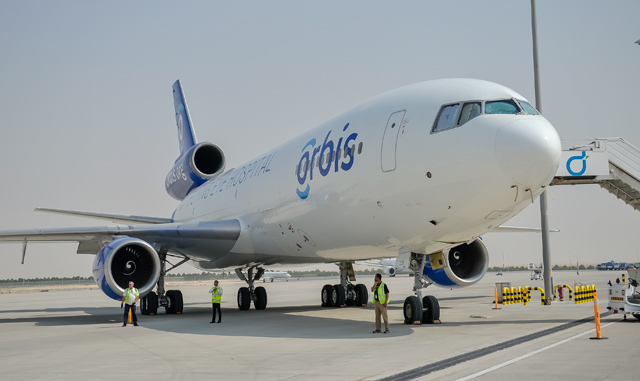Among the aircraft at the Dubai air show sits a special Boeing MD-10 that has been converted into a hospital to deliver sight-saving surgeries and training for doctors in developing countries.
Orbis’s Flying Eye Hospital combines the mobility of an aircraft with its own support facilities with a world-class teaching hospital. Flight Daily News was given a tour of the aircraft by Orbis’s director of aircraft operations, former FedEx pilot Bruce Johnson.
The front section of the aircraft features a typical airliner-style set-up with a small number of seats and overhead lockers. While they are used to seat staff during flights, when the aircraft is on the ground the area functions as a lecture hall. Video from cameras in the operating room is fed into the area, and students can watch and interact with the surgeons.
Johnson says that training eye surgeons in the areas that Orbis operates is its primary mission, and while people do receive sight-saving surgeries on the aircraft, those surgeries are part of a bigger vision.
“It’s never about 'one-and-done'; it’s about sustainable training,” he says.
Immediately behind the seating area is a large bulkhead, which Johnson says “is where the freighter begins”. He explains that the hospital section of the aircraft is actually a number of palletised modules that lock together, while providing the experience of a hospital that could be anywhere else in the Western world.
“We couldn’t do this in any other aircraft than a freighter,” he adds.
Another section is home to an array of microscopes, other diagnostic equipment, and an eye surgery simulator, which Johnson says is critical for training – particularly as a number of countries do not allow medical students to operate on people.
“As with flying, we think the future of surgical education is going to be in simulation,” says Johnson.
Behind that area is the operating theatre, which again would not be out of place at any leading hospital.
Staff nurse Jacqueline Newton explains: “We do about five cases here on the plane, but what’s really great is that we do the same type of training in surgery at the local hospital, in their environment and their resources. So here on the plane we show them so they are able to implement it in their environment and keep it as 'best practice' as possible.”

The theatre is equipped with a number of cameras that feed to the teaching area at the front of the aircraft. It is also supported by a sterilisation area – procedures are just the same as in any leading hospital to prevent the spread of contaminants – and a recovery facility at the rear of the aircraft.
Keeping the flying eye hospital going is no mean feat. Johnson says it takes about four hours to convert the MD-10 from flying mode to hospital mode, which includes unpacking beds and other equipment stowed away while in transit, as well as giving it a major clean-down to ensure that it is ready to be used as a hospital.
The flying hospital also uses the large cargo capacity to carry its own ground support equipment, and its specialised cooling system. It also carries an on-board oxygen generator and an advanced water purification system. “We purify water and can kill every bacteria known to man,” says Johnson.
It also carries its own biomedical engineers to maintain the equipment, as well as aircraft mechanics to keep the MD-10 in the air.
Most deployments last between two and four weeks, and are part of a long-term programme that the organisation may run with a country’s health services over a number of years. It returns to the US only for resupply and while transiting between continents.
“We’ve been around since 1982 so it’s been in existence for a long time, and a lot of people don’t know us very well in the Western world, because 90% of the visually impaired people are in developing countries,” says Johnson.
The MD-10, which started life as a DC-10-30 in 1983, has helped to lift awareness of Orbis’s work globally.
“The plane becomes a very good advocacy tool for us; it’s hard to miss this 500,000 pound object out here,” says Johnson.
Nowadays, however, the flying eye hospital represents only about a quarter of the work that Orbis does. With its focus on education, it has developed Cybersight, an online learning tool for eye surgeons that can be accessed from anywhere with an internet connection. Similarly, it has long-term programmes aimed at helping to equip hospitals and train eye surgeons within them.
Underpinning all those are an army of volunteer surgeons, pilots and others, and it is reliant on a range of sponsorships to keep operating.
“Everything we provide is free of charge, so it’s our individual sponsors and business sponsors that support us,” says Johnson.
UTC Aerospace Systems, for instance, has committed to providing $1 million over three years to Orbis, while it also receives a large amount of in-kind support from FedEx, as well as support from various charitable trusts and foundations.
For all the coverage from the Dubai air show visit our dedicated event page
Source: Flight Daily News


























